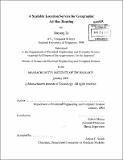A scalable location service for geographic ad hoc routing
Author(s)
Li, Jinyang, 1976-
DownloadFull printable version (2.181Mb)
Other Contributors
Massachusetts Institute of Technology. Dept. of Electrical Engineering and Computer Science.
Advisor
Robert Morris.
Terms of use
Metadata
Show full item recordAbstract
GLS is a new distributed location service which tracks mobile node locations. GLS combined with geographic forwarding allows the construction of ad hoc mobile networks that scale to a larger number of nodes than possible with previous work. GLS is decentralized and runs on the mobile nodes themselves, requiring no fixed infrastructure. Each mobile node periodically updates a small set of other nodes (its location servers) with its current location. A node sends its position updates to its location servers without knowing their actual identities, assisted by a predefined ordering of node identifiers and a predefined geographic hierarchy. Queries for a mobile node's location also use the predefined identifier ordering and spatial hierarchy to find a location server for that node. Experiments using the ns simulator for up to 600 mobile nodes show that the storage and bandwidth requirements of GLS grow slowly with the size of the network. Furthermore, GLS tolerates node failures well: each failure has only a limited effect and query performance degrades gracefully as nodes fail and restart. The query performance of GLS is also relatively insensitive to node speeds. Simple geographic forwarding combined with GLS compares favorably with Dynamic Source Routing (DSR): in larger networks (over 200 nodes) our approach delivers more packets, but consumes fewer network resources.
Description
Thesis (S.M.)--Massachusetts Institute of Technology, Dept. of Electrical Engineering and Computer Science, February 2001. "January 2001." Includes bibliographical references (p. 55-57).
Date issued
2001Department
Massachusetts Institute of Technology. Department of Electrical Engineering and Computer SciencePublisher
Massachusetts Institute of Technology
Keywords
Electrical Engineering and Computer Science.